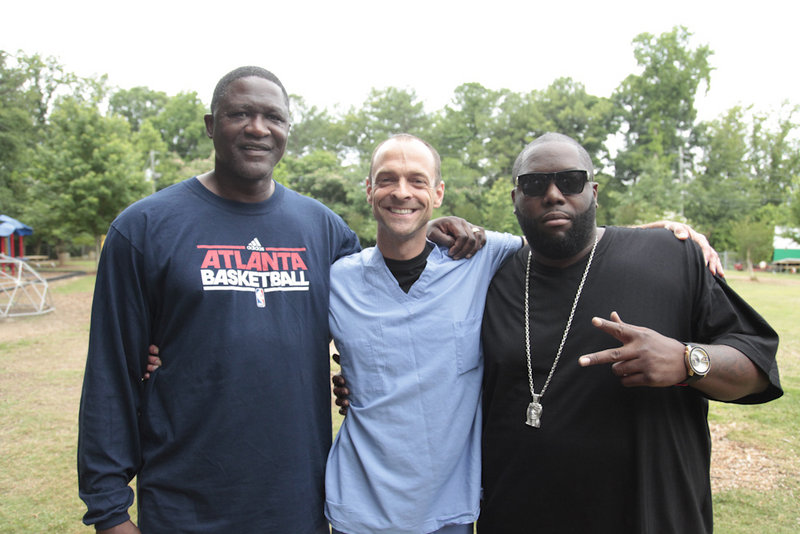Dr. Kevin Strong knows the public-health community is being outspent and outmaneuvered by the makers of junk food. But he’s not willing to shrug his shoulders and let the hucksters of soda, candy and processed foods win the battle for children’s stomachs and, by extension, the war over obesity.
“As physicians and a medical community, we’ve done a poor job of public-health branding,” said Strong, a pediatrician from Camden. “There’s public-health information we want to get to the public, but we don’t brand it the way a junk food company would.”
To counter the slick marketing messages of those selling sugar-filled foods and drinks, Strong launched “Dunk the Junk” two years ago Friday. Using street-style elements frequently found in TV commercials — such as hip-hop, graffiti and basketball — Dunk the Junk is reaching kids from coast to coast with the message that it’s cool to toss out the junk food and eat real foods instead.
To date, Dunk the Junk has worked with Camden schools, the Emma Hutchinson Elementary School in Atlanta and the Palm Springs Unified School District in California.
Strong and the artists who work with him also brought their message to the Art Basel show in Miami last month, the Food Day celebrations in Boston last October and the Center for Maine Contemporary Art last winter.
In Atlanta, Strong was joined in showing the hip side of fruits and vegetables by rapper Killer Mike and retired Atlanta Hawks basketball player Dominique Wilkins, an NBA Hall of Famer known for his thunderous dunks.
As part of the Atlanta event, students wrote and performed their own raps. A quartet of fifth-grade boys, calling itself The ShortyZ, won the competition with a song that included the lyrics: “Veggies are our lifetime, eat ’em all day/ If you don’t wannabe fat, throw all the junk away.”
The song’s catchy chorus goes “Dunk the junk/Dunk the junk/Throw away the candy/That’s what’s up.”
Dunk the Junk is funded by private donations. Most of the schools it works with have grant funding to promote nutrition that they use to pay for the Dunk the Junk program and materials.
Portland artist Mike Rich, who primarily works in aerosol and is known for his graffiti-style murals, has traveled around the country with Strong, painting images of evil soda cans and happy fruits.
“When I was in school, I remember seeing outdated videos and corny things that would try to teach us about nutrition,” Rich said. “I think it’s pretty smart of (Strong) to put it in a shiny new package.”
At some of the schools they’ve visited, Rich has worked with the teachers to have students submit drawings to him. He then picks the best ones and incorporates their characters into a permanent Dunk the Junk mural he creates at the school.
“I’m doing something that will be there when we pack up and leave,” Rich said. “Hopefully, they’ll remember what they learned through that.”
Rich views graffiti art, with its anti-establishment roots, as an ideal medium to communicate healthy food messages to kids.
“I see graffiti art as being the antithesis of marketing and packaging,” Rich said. “A lot of natural foods — fruits, water — it’s all bland packaging. They lack the marketing of Kellogg’s or Nestle.”
Statistics show that nearly one in three American children are overweight or obese, and Strong has seen the reality of this firsthand in his young patients. Particularly troubling to him are the youngsters who’ve developed diabetes from eating too much junk food and not enough real food.
“Your body has evolved over hundreds of thousands of years to eat food directly from the land,” Strong said. “You can’t take the sugar of 10 oranges and squeeze it out and eat it and not expect your pancreas to be overwhelmed by the volume of sugar.”
While the consequences of diabetes are severe — including blindness, limb amputation and heart disease — Strong finds that non-medical messages work best with parents.
He said the most effective tack to take is to present the obesity epidemic in terms of the marketing manipulation they and their children are exposed to each day.
“If you tell them that food companies are making a lot of money by selling them sugar, no one likes getting duped by fat cats,” Strong said. “Mainers, especially, don’t like to be hoodwinked.”
As an example, he mentioned a trip to the grocery store he took with a patient’s mother. His goal was to help the family identify and purchase whole foods and healthier foods.
In the cereal aisle, the mom spotted a box of Multigrain Cheerios and recognized the cereal as a sponsor of the weight loss reality show “The Biggest Loser.”
“When we turned (the box) around and found it actually had four times more sugar than regular Cheerios, that was really powerful to her,” Strong said.
The experience showed her how she was being misled by Cheerios’ clever marketing, Strong said. She vowed to never purchase the brand again.
Counter to the popular perception that lack of exercise is the main cause of obesity, Strong said, “I want to make really clear (that) sugar is what’s pushing the obesity epidemic.”
In December, he wrote to first lady Michelle Obama asking her to consider renaming her “Let’s Move” campaign to “Let’s Not Drink Sugar.”
“I can show you 20 papers that show exercise won’t put a dent in the obesity epidemic,” Strong said. “But the government is not challenging Big Sugar. We need to let people know that sugar is bad. Soda is terrible.”
But the solution is simple: Just dunk the junk.
Staff Writer Avery Yale Kamila can be contacted at 791-6297 or at:
akamila@pressherald.com
Twitter: AveryYaleKamila
Send questions/comments to the editors.





Comments are no longer available on this story